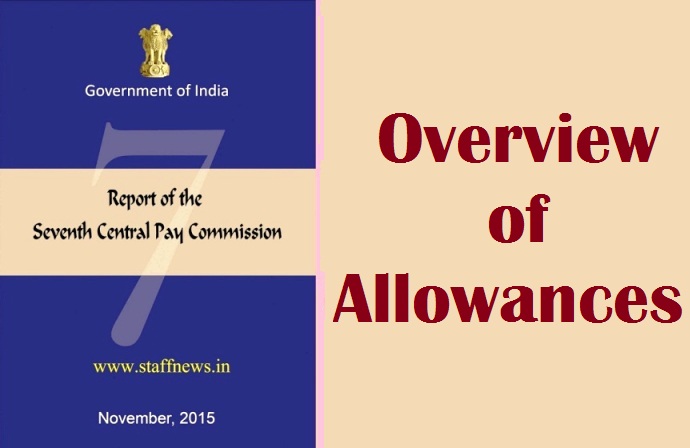Overview
of
Allowances
Chapter
8.2
ToR
Definition
Pay, or as a specified amount. In the case of the latter the amount usually varies with the employee’s level or status, with Children Education Allowance
being the notable exception for which the absolute amount is the same across all ranks. Barring a few exceptions, allowances do not normally count for
calculation of other allowances and pensionary benefits. Here it is pertinent to mention that there exist another set of payments also classified as
“allowances” that are in the nature of administrative expenditure, such as Band Allowance, Recruiting Allowance, etc. These are granted to the concerned
unit and not to an individual. The Commission is of the view that such “allowances”should henceforth be referred to simply as expense or expenditure and the word “allowance” should be used only if it is paid to an individual.
General
Observations
The number of allowances paid to government employees in India is quite large, and there are demands for even more allowances. The trend worldwide,
however, is otherwise–to include most of the additional items of remuneration as part of the Basic Pay and minimize the number of allowances. The
Commission, in its recommendations, has tried to reconcile both the points of view, keeping the unique conditions of our country in mind
The entire range of allowances is administered in broadly four ways:
- a. Fully DA-indexed–Allowances that are in the nature of fixed amounts, but the amount is fully indexed to Dearness Allowance(DA), e.g. Transport Allowance
- b. Partially or Semi DA-indexed–Allowances that are in the nature of fixed amounts, but the amount increases by 25 percent each time DA rises by 50
percent, e.g. Field Area Allowance, Siachen Allowance. - c. No DA-indexation–Allowances that are in the nature of fixed amounts, but the amount does not change with DA, e.g. Reward for Meritorious Service.
- d. Percentage based–Allowances that are paid as a percentage of Basic Pay, e.g. House Rent Allowance, and in some cases as a percentage of Basic Pay+DA,
e.g. Special Security Allowance to the staff of SPG, NSG and NIA.
the rates vary. One such example is Night Duty Allowance. The Commission has tried to ensure parity for such allowances.
distinguished and the context can be clearly brought out. An example is the “Special Allowance” paid to members of the expedition team visiting Antarctica.
We have named it “Antarctica Allowance.”
and are now by and large stabilized. Given the time frame of the Commission, it is not possible to examine each condition associated with every allowance.
However, wherever it has been brought to the notice of the Commission in its meeting with the stakeholders, we have brought in necessary changes aiming to
enhance the ease of implementation. Accordingly, unless otherwise mentioned, the scope, rules/regulations and set of conditions governing the grant of an allowance shall remain unaltered.
General
Approach
cease to exist immediately. In case there is any demand or requirement for continuation of an existing allowance which has not been deliberated upon or
covered in this report, it should be re-notified by the ministry concerned after obtaining due approval of Ministry of Finance and should be put in the
public domain.
3. Every allowance has been examined and analysed using the following approach:
- a. Need for continuation: The genesis of every allowance has been studied with a view to identify the precise reason and basis for payment of that
allowance. Over a period of time many processes and work situations in the government have evolved and undergone changes so as to render the need for
certain allowances infructuous. Based on the analysis, an assessment of the need for continuation of each allowance has been made. - b. Coverage: For such allowances as are being recommended for continuation, the set of people who are presently covered by the allowance has been
examined to see if the same is appropriate. - c. Rationalisation: Again, for those allowances that are being recommended for continuation, the
following set of issues has been gone into:
- i. Is the present rate appropriate?
- ii. Can the allowance be clubbed with any other similar allowance?
- iii. Can the allowance be rationalized?
that are in the nature of a fixed amount but not DA indexed have generally been raised by a factor of 2.25. Allowances that are in the nature of a fixed
amount but are partially indexed to DA have generally been raised by a factor of 1.5. Allowances that are in the nature of a fixed amount but fully indexed
to DA have not been given any raise. Regarding percentage based allowances, having regard to the increase in the pay structure (and consequently the Basic
Pay) as a result of the recommendations of this Commission, and keeping in mind the raise granted to slab-based allowances, the quantum of percentage based
allowances has been rationalized by a factor of 0.8.
realities and the proposed pay structure in mind.
Summary
of
Recommendations
either in an existing allowance or in newly proposed allowances. Allowances relating to Risk and Hardship will be governed by the proposed Risk and
Hardship Matrix.
Stay connected with us via Facebook, Google+ or Email Subscription.
Subscribe to Central Government Employee News & Tools by Email [Click Here]
Follow us: Twitter [click here] | Facebook [click here] | Google+ [click here]
Admin

COMMENTS